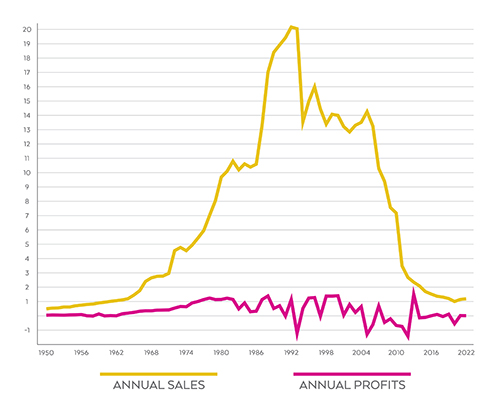KODAK'S WILD RIDE
The Eastman Kodak Company was officially formed in 1901, right after the company invented the first inexpensive, portable, personal camera. By 1992, Kodak was a $20 billion company, and the 18th largest business by revenue in the United States. Twenty years later, the company filed for bankruptcy. Kodak's story has become a classic, cautionary tale about a business that developed tunnel vision, refused to diversify, and actively fought technological developments. It's an overly simplified story that is easier for us to understand and repeat, but the actual data tells a different story.
Kodak didn't invent photography, cameras, or film, but Kodak made all of those things matter to us, and created a culture that redefined how we as humans view the moments of our lives, capture our memories, and communicate with each other. You can learn all about that in this month's episode of our sister podcast, How Marketing Changed the World. But that idea is important to remember, because the same culture that catapulted Kodak to the top 20 businesses in the country was also the culture that eventually took it all away.
Being such an old company, Kodak's sales were inconsistent throughout the beginning of the 20th century due to the interruptions of two world wars and a global depression. But following its revenue beginning in 1950, Kodak climbs rather precipitously from $500 million to $20 billion over the span of 40 years. Two major spikes can be observed in the mid-1970s and the mid-1980s. The first spike correlates with Kodak's highest market share film (90%) and camera (85%) sales, according to a 2005 Harvard business study. At that time, in 1975, Kodak invented the digital camera, which at that time was large, slow, and only took black-and-white photographs. The second spike was driven by Kodak's diversification into copiers, computer storage, diagnostics, and pharmaceuticals through acquisitions.
KODAK'S ANNUAL REVENUE AND EARNINGS IN BILLIONS OF DOLLARS

This period of radical growth was primarily fueled by Kodak's film division due to its enormous profit margins. Kodak enjoyed an 80% margin on its film products, and as it evolved and diversified, it became extremely difficult to maintain those giant margins in any other areas. That became apparent in the 1990s when Kodak seemingly made all the right moves. It introduced the first consumer digital cameras for under $1000, and in 2001, it purchased Ofoto, which would become the Kodak EasyShare Gallery, one of the first online photo-sharing websites. Despite these technological developments, and Kodak gaining the primary market share of digital camera sales in the United States, its profits became very unstable, spiking between billion-dollar gains and billion-dollar losses. Kodak's earnings throughout the 1970s and 1980s averaged $600 million. In 2005, when Kodak was the number one digital camera seller in the United States and third overall globally, it posted a $1.3 billion loss.
While Kodak certainly made mistakes, it's unfair to blankly accuse them of tunnel vision, refusal to diversify, and avoidance of technology. The reality is that lucrative film revenues created a corporation that functioned at level that became untenable as photography evolved. Most analyses of Kodak focus on the steep rise and fall of its revenues. Doing so usually describes Kodak as a $20 billion company that lost it all in 20 years. Another way to look at the data is to consider Kodak a $1 billion company that experienced a wild, 40-year surge due to film processing. That view would actually fit better with the dramatic changes that occurred in photography over the same span of time.
Kodak changed our culture to redefine our memories as photographs. As that idea became more engrained in everyone's minds, it makes sense that the number of photos and volume of film processing would grow dramatically. It also makes sense that as technology developed, solutions would emerge and quickly become more popular that made photographs quicker and easier to take everywhere all the time. What no one could have predicted is how large and global that idea would become. People all over the world wanted to photograph everything so much that cameras disappeared into phones. And people wanted to share their photo with everyone so much that printed images disappeared into online social sites. Basically, the idea of photographs became so big that almost every photographic product Kodak had ever created vanished. Kodak had unwittingly created its own devouring monster.
Much has been made of Kodak's failure to react and diversify, especially with digital products. But what most people fail to realize is that the digital camera market existed in a typical tech bubble. They became commercially viable in the early 1990s and were supplanted by phones before 2010. Even if Kodak had executed its digital strategy perfectly, the profit margins and short window of opportunity would not have yielded much difference. As for online photo sharing, Kodak clearly couldn't envision a profitable vehicle in it, so it sold the Kodak EasyShare Gallery to Shutterfly during its bankruptcy proceedings for $20 million. It turns out Kodak was right. Last year Shutterfly made $2.2 billion - more than Kodak, but a far cry from the double-digit billions Kodak was looking to reclaim.
The rise and fall of Kodak becomes a very different conversation if one focuses on its net earnings rather than its gross revenues. Kodak's soaring sales never resulted in equally soaring profits. On the contrary, its net earnings became erratic, wildly oscillating between gains and losses of just over $1 billion. Even including the years before bankruptcy when Kodak was bleeding money, its mean profit for the past 70 years was $332 million. The standard deviation for that data was 655 million, which becomes apparent when viewing a graph of Kodak's profits between the years of 1988 and 2014. So while Kodak's revenues increased by 4300% between 1950 and 1992, its profits only rose by 180%. One could liken the graph to the diminished control a driver has as a vehicle is pushed to its maximum possible speed. Perhaps those same limitations exist in different areas of industry, and analyzing the data of revenues and earnings can reveal when sales begin creating uncontrollable profits, or certainly when profits fail to grow with sales.
The data on Kodak doesn't paint a picture of a company that could have kept growing indefinitely, but blew it due to poor business decisions. It seems to depict a company that grew beyond not only its own capacity, but the overall capacity of its industry, and the market simply corrected itself. Maybe it was the Icarus paradox, where the very things that led to Kodak's success created its downfall. Maybe it was just the realities and inevitable evolution of the photography market. Maybe it was a little of both. Regardless, it certainly wasn't the simple story that keeps being repeated. And as a final note, in 2022 Kodak reported $1.2 billion in sales and $26 million in profit. For those that love to pretend that Kodak no longer exists, I'd love to see their billion-dollar businesses that they feel aren't worth their time.
SOURCES
- "A Database of 50 Years of FORTUNE's List of America's Largest Corporations" from CNN
- "Kodak and the Digital Revolution" from Harvard Business School
- "What’s Wrong with This Picture: Kodak’s 30-year Slide into Bankruptcy" from Wharton School of the University of Pennsylvania
- "Kodak Retains Lead in U.S. Digital Cameras" from Washington Post
- "The Physics of Speeding Cars" from Australian Academy of Science
- "Businesses and the Icarus Paradox" from Harvard Business Review
- All revenue and earnings data from annual reports of Eastman Kodak and Shutterfly













